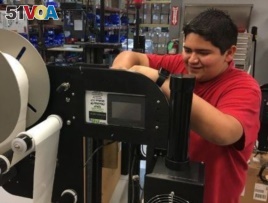14 May, 2019
Americans are remembering students who died in recent weeks while trying to stop gunmen at two schools in the United States. Some people have praised the students for their actions, calling them heroic.
Their actions demonstrate growing public support for guiding students on what they can do, in some situations, to stop armed attackers. Experts say educators should offer teachers and students as many choices as possible for how to deal with an active shooter - including fighting back.
On April 30, a gunman opened fire at the University of North Carolina at Charlotte. The university sent students messages on their phones that read "Run, Hide, Fight."
Riley Howell chose to fight. He lost his life trying to stop the shooter. The local police chief described the 21-year-old student as "the first and foremost hero." He said if Howell had not tackled the gunman, more students could have died. Along with Howell, one other student died in the attack.
Nine days later, Kendrick Castillo was killed trying to stop a gunman who had entered the STEM School Highlands Ranch in Colorado.
The school sits less than 15 kilometers from Columbine High School. That is where, 20 years ago, two gunmen killed 12 students and a teacher.
Like Howell, the 18-year-old Castillo was described as a hero whose actions helped save lives.

Kendrick Ray Castillo, 18, was killed during a shooting Tuesday at the Science, Technology, Engineering and Math (STEM) School in Highlands Ranch, Colorado.
The STEM school uses a "Locks, Lights, Out of Sight" method for dealing with active shooters. A school official would not say whether the school had ever suggested students fight back against an active shooter.
But student Brendan Bialy had thought about it on his own. And, on May 8, he joined Castillo in diving toward the gunman and taking the gun away. Bialy, who is also 18, survived the shooting.
The next day, he told reporters, "I don't like the idea of running and hiding....Somebody like that, I'm going to fight them there."
There always have been students willing to take action, notes Greg Crane. He founded a for-profit group called the ALICE Institute. The name ALICE is short for Alert, Lockdown, Inform, Counter, Evacuate.
Crane says he created the institute in 2001 based on what had already been done by students who brought down shooters themselves.
Crane said many people have a "warrior mindset, a hero mindset." He noted the importance of providing information and training so that, in Crane's words, "when they are the first one to stand up and start moving to do something, maybe they're not alone."
The institute's training has been offered to educators from over 5,000 public school districts, Crane said. Often, police officers lead the training programs. Crane said the program does not teach ways of fighting back. Instead, it advises people to make noise, create disorder and confuse the attacker.
In the state of Maryland, Baltimore County Public Schools started offering ALICE this year.
If a shooter gets too close, students are told to find any object they can and throw it at the attacker. Students also should shout and make other loud noises. The idea is to create enough disorder to escape.
Young children are told not to make physical contact with the attacker. But teachers and older students have that choice, said George Roberts, the head of Baltimore County Public Schools.
Roberts said, "The adults are trained how to grab the arms, grab the legs" and get control of the attacker until police arrive.
"This more active response provides a level of choice," Roberts added.
Roberts was principal at Maryland's Perry Hall High School in 2012, when a student brought a gun into the meal room and wounded another student.
Karen Shepard has several children and grandchildren. Their Athens, Pennsylvania, school district adopted ALICE training this year. Shepard says she wants the children to know not to gather in just one part of the classroom if a gunman enters the room.
"They should barricade, they should have something in their hands," Shepard said. "At least they'd have a fighting chance."
It is not an easy discussion to have with students at any age, said Joseph Eradi. He was school superintendent in Newtown, Connecticut, after a gunman killed 26 people at an elementary school there.
Eradi said, ‘What we've learned over time is to provide staff and students with as many options as possible in the moment."
He added, "You never want to take that common sense element out."
I'm Ashley Thompson.
The Associated Press reported this story. Ashley Thompson adapted it for VOA Learning English. Caty Weaver was the editor.
____________________________________________________________
Words in This Story
tackle - v. to forcefully seize (someone) and cause that person to fall to the ground
alert - adj. able to think clearly and to notice things
lock - v. to fasten the door, lid, etc., of (something) with a lock
counter - v. to do something in defense or in response to something — often + with
evacuate - v. to remove (someone) from a dangerous place
confuse - v. to make (someone) uncertain or unable to understand something
grab - v. to quickly take and hold (someone or something) with your hand or arms
principal - n. the person in charge of a public school
barricade - v. to block (something) so that people or things cannot enter or leave
option - n. the opportunity or ability to choose something or to choose between two or more things